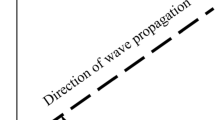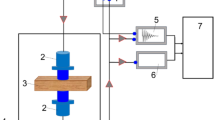Abstract
This paper deals with a new hybrid method coupling an analytical and finite element approach for the calculation of the ultrasonic wave propagation velocity in orthotropic materials applied to timber elements. First, the method consists of integrating an analytical model described for orthotropic materials by considering a misalignment of the ultrasonic wave propagation direction with the main orthotropic reference. A second step calls for implementation in a finite element approach. This coupling allows for the computation of wave propagation velocity by assuming a heterogeneous material induced by means of a moisture content gradient in timber elements exposed to outdoor conditions inducing a non-homogeneous distribution of mechanical properties such as moduli of elasticity integrating the orthotropic character of wood. The result of this work proposes a highly efficient hybrid numerical approach, yet without solving the dynamic finite element problem, which typically requires a very long computation time while benefiting from a finite element support to project the different mechanical and hydric fields.


















Similar content being viewed by others
References
Alves RC, Mantilla JNR, Bremer CF, Carrasco EVM (2015) Application of acoustic tomography and ultrasonic waves to estimate stiffness constants of muiracatiara Brazilian wood. Bioresources 10(1):1845–1856
Bucur V (2006) The acoustics of wood, CRC Press, ISBN: 978–3–540–30594–1
Cuxac P (1991) Propagation et atténuation des ondes ultrasoniques dans des roches fissurées et anisotropes (Propagation and attenuation of ultrasonic waves in cracked and anisotropic rocks), PHD Thesis, National Polytechnic Institute of Lorraine
Dackermann U, Elsener R, Li J, Crews K (2016) A comparative study of using static and ultrasonic material testing methods to determine the anisotropic material properties of wood. Constr Build Mater 102–2:963–976
De Oliveira FGR, Candian M, Lucchette FF, Salgon JL, Sales A (2005) Moisture content effect on ultrasonic velocity in Goupia Glabra. Mater Res 8:11–14. https://doi.org/10.1590/S1516-14392005000100004
Dündar T, Wang X, As N, Avcı E (2016) Potential of ultrasonic pulse velocity for evaluating the dimensional stability of oak and chestnut wood. Ultrasonics 66:86–90. https://doi.org/10.1016/j.ultras.2015.11.007
Espinosa L, Brancheriau L, Prieto F, Lasaygues P (2018) Sensitivity of ultrasonic wave velocity estimation using the christoffel equation for wood non-destructive characterization. Bioressources 13(1):918–928. https://doi.org/10.15376/biores.13.1.918-928
Gonçalves R, Lorensani RGM, Negreiros TO, Bertoldo C (2018) Moisture-related adjustment factor to obtain a reference ultrasonic velocity in structural lumber of plantation hardwood. Wood Mater Sci Eng 13:254–261. https://doi.org/10.1080/17480272.2017.1313312
Guitard D, El Amri F (1987) Modèles prévisionnels de comportement élastique tridimensionnel pour les bois feuillus et les bois résineux (Predictive models of three-dimensional elastic behavior for hardwoods and softwoods). Ann For Sci 44:335–358. https://doi.org/10.1051/forest:19870305
Kabir MF, Daud WM, Khalid K, Sidek HAA (1998) Effect of moisture content and grain direction on the dielectric properties of rubber wood at low frequencies. Holzforschung 52:546–552. https://doi.org/10.1515/hfsg.1998.52.5.546
Kabir MF (2001) Prediction of ultrasonic properties from grain angle. J Inst Wood Sci, 15(5): 235–246. ISSN 0020–3203
Kollmann FFP, Kuenzi EW, Stamm AJ (2012) Principles of wood science and technology: II wood based materials. Springer. https://doi.org/10.1007/978-3-642-87931-9
Komatitsch D, Barnes C, Tromp J (2000) Simulation of anisotropic wave propagation based upon a spectral element method. Geophysics 65(4):1251–1260. https://doi.org/10.1190/1.1444816
Kurz JH, Grosse CU, Reinhardt H-W (2005) Strategies for reliable automatic onset time picking of acoustic emissions and of ultrasound signals in concrete. Ultrasonics 43:538–546. https://doi.org/10.1016/j.ultras.2004.12.005
Lasaygues P, Arciniegas A, Brancheriau L (2014) Comparaison de méthodes de tétection de TOF adaptées à la tomographie ultrasonore des arbres sur pied (Comparison of TOF detection methods adapted to ultrasound tomography of standing trees), 12th French Acoustics Congress, Poitiers, France, ISBN 978-2-919340-02-6
Manfoumbi N, Nguyen TA, Angellier N, Dubois F, Ulmet L, Sauvat N (2014) Experimental and numerical aspects in diffusion process characterization in tropical species. Eur J Environ Civ Eng 18(9):963–982. https://doi.org/10.1080/19648189.2014.917993
Marra GG, Pellerin RF, Galligan WL (1966) Nondestructive determination of wood strength and elasticity by vibration. Holz Roh- Werkst, 24: 460–466, ISSN: 1436-736X, 0018-3768
Masumi H, Masato T, Junji M, Kazuyuki O (2011) Effect of wood properties on within-tree variation in ultrasonic wave velocity in softwood. Ultrasonics 51(3):296–302. https://doi.org/10.1016/j.ultras.2010.10.001
Matsunaga W, Mizukami K, Mizutani Y, Todoroki A (2022) Estimation of the moisture absorption rate of glass fiber reinforced plastic, using electromagnetic induction testing. Compos Part C: Open Access, https://doi.org/10.1016/j.jcomc.2022.100260
McDonald D, Begel M, Senalik CA, Ross R (2014) Creep behavior of structural insulated panels (SIPs): results from a pilot study. USDA For Serv For Prod Lab Res Note FPL-RN-0332, 2014 16 P 332, 1–16
Merakeb S, Dubois F, Petit C (2009) Modeling of the sorption hysteresis for wood. Wood Sci Technol 43(7–8):575–589. https://doi.org/10.1007/s00226-009-0249-2
Nguyen TA, Angellier N, Caré S, Ulmet L, Dubois F (2017) Numerical and experimental approaches to characterize the mass transfer process in wood elements. Wood Sci Technol 51(4):811–830. https://doi.org/10.1007/s00226-017-0898-5
Norimoto M, Yamada T (1970) The dielectric properties of wood IV: on dielectric dispersions of oven-dried wood. Bull Wood Res Inst Kyoto Univ 50:36–49
Orta AH, Vandendriessche J, Kersemans M, Paepegem WV, Roozen NB, Abeele KVD (2021) Modeling lamb wave propagation in visco-elastic composite plates using a fifth-order plate theory. Ultrasonics. https://doi.org/10.1016/j.ultras.2021.106482
Pradhan T (2014) Finite Element Modeling of Impact-Generated stress wave propagation in concrete plates for non-destructive evaluation. PHD Thesis, Lehigh University
Rosenkrantz E, Bottero A, Komatitsch D, Monteiller V (2019) A flexible numerical approach for non-destructive ultrasonic testing based on a time-domain spectral-element method: Ultrasonic modeling of Lamb waves in immersed defective structures and of bulk waves in damaged anisotropic materials. NDT E Int 101:72–86. https://doi.org/10.1016/j.ndteint.2018.10.002
Ross RJ (1994) Nondestructive testing for assessing wood members in structures: a review, general technical report FPL; GTR-70. For Prod Lab. https://doi.org/10.2737/FPL-GTR-70
Royer D, Dieulesaint E, De Gennes PG (1996) Ondes élastiques dans les solides - Tome 1: Propagation libre et guidée (Elastic waves in solids – Vol. 1: Free and guided propagation), Masson Edition, ISBN 9782225854224 et 222585422X
Sakai H, Minamisawa A, Takagi K (1990) Effect of moisture content on ultrasonic velocity and attenuation in woods. Ultrasonics 28:383–385
Seron FJ, Sanz FJ, Kindelan M, Badal JI (1990) Finite-Element Method for Elastic Wave Propagation. Commun Appl Numer Methods. https://doi.org/10.1002/cnm.1630060505
Silva C, Branco J, Mehdipour Z, Xavier J, Lourenço P (2022) Experimental stress analysis of cross-laminated timber elements under cyclic moisture. J Mater Civ Eng 34:8. https://doi.org/10.1061/(ASCE)MT.1943-5533.0004336
Sridhar R, Chakraborty A, Gopalakrishnan S (2006) Wave propagation analysis in anisotropic and inhomogeneous uncracked and cracked structures using pseudospectral finite element method. Int J Solids Struct 43(16):4997–5031. https://doi.org/10.1016/j.ijsolstr.2005.10.005
Torgovnikov GI (1993) Dielectric Properties of wood and wood-based materials, Springer: Berlin Heidelberg, ISBN: 978-3-642-77455-3
Varnier M, Sauvat N, Ulmet L, Montero C, Dubois F, Gril J (2020) Influence of temperature in a mass transfer simulation: application to wood. Wood Sci Technol 54(4):943–962. https://doi.org/10.1007/s00226-020-01197-y
Varnier M, Sauvat N, Montero C, Dubois F, Gril J (2018) Adaptation of Eurocode 5 standard to French hardwoods—Proposal of new hygroscopic equilibrium charts, Proc. Meeting 51 INTER, Tallin
Vössing KJ, Niederleithinger E (2018) Nondestructive assessment and imaging methods for internal inspection of timber. A review. Holzforschung 72(6):467–476. https://doi.org/10.1515/hf-2017-0122
Wang X (2008) Effects of size and moisture on stress wave E-rating of structural lumber. 10th World Conference on Timber Engineering: Miyazaki, Japan
Zhang H (2003) Automatic P-wave arrival detection and picking with multiscale wavelet analysis for single-component recordings. Bull Seismol Soc Am 93:1904–1912. https://doi.org/10.1785/0120020241
Zhang X, Shao S, Shao S (2021) A recursive legendre polynomial analytical integral method for the fast and efficient modelling guided wave propagation in rectangular section bars of orthotropic materials. Int J Acous Vib 26(3):221–230. https://doi.org/10.20855/ijav.2021.26.31772
Zhang X (2021) Surveillance et Auscultation des Ouvrages en bois par Identification des Champs Hydrique et Mécanique : Couplage des Méthodes Acoustiques et Electromagnétiques (Monitoring and Auscultation of Timber Structures by Identification of Hydric and Mechanical Fields: Coupling of Acoustic and Electromagnetic Methods), PHD thesis, Limoges University
Zisi A, Dix JK (2017) Simulating mass loss of decaying waterlogged wood: a technique for studying ultrasound propagation velocity in waterlogged archaeological wood. J Cult Herit 33:39–47. https://doi.org/10.1016/j.culher.2018.02.016
Acknowledgements
This work is part of the research project ‘SOUBOIS’ founded by the French region ‘Nouvelle Aquitaine.’
Author information
Authors and Affiliations
Corresponding author
Additional information
Publisher's Note
Springer Nature remains neutral with regard to jurisdictional claims in published maps and institutional affiliations.
Rights and permissions
Springer Nature or its licensor (e.g. a society or other partner) holds exclusive rights to this article under a publishing agreement with the author(s) or other rightsholder(s); author self-archiving of the accepted manuscript version of this article is solely governed by the terms of such publishing agreement and applicable law.
About this article
Cite this article
Zhang, X., Dubois, F., Sauvat, N. et al. Hybrid numerical method for the ultrasonic wave propagation velocity in orthotropic materials. Wood Sci Technol 56, 1605–1630 (2022). https://doi.org/10.1007/s00226-022-01416-8
Received:
Accepted:
Published:
Issue Date:
DOI: https://doi.org/10.1007/s00226-022-01416-8




